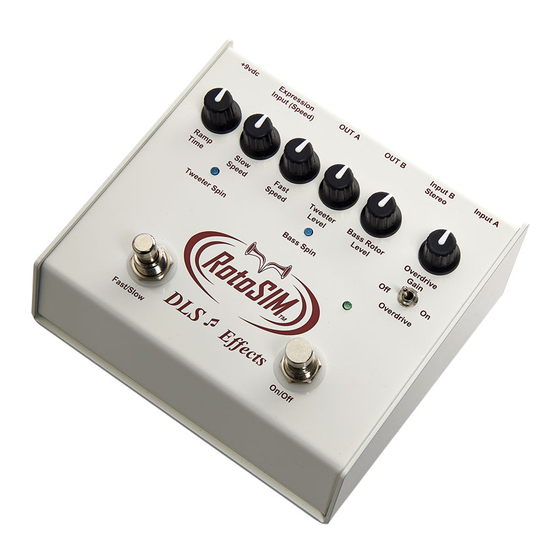
Advertisement
RotoSIM
+9vdc
Ramp
Time
Note1: Output A is designed to sound slightly different than Output B. OUTA is a little more transparent and truer sounding.
Output B is deeper and thicker sounding. The musician can experiment with both outputs while the instrument is plugged
into INA. (This also gives a nicer stereo sound spread when used in stereo).
Note2: Fast Speed and Slow Speed knobs are set at factory so 12 o'clock is the actual speed of a Leslie (knobs are offset)
Features:
Fast/Slow Switch: Select Fast or Slow speed by pushing and releasing this momentary switch
On/Off Switch:
Controls how long it takes to ramp up or down to the set speed (when switching from Fast to
Ramp Time:
Slow, or Slow to Fast speeds)
Controls Slow speed (knob factory set so 12:00 O'clock is actual Rotating speaker slow speed)
Slow Speed:
Controls the Fast speed (knob factory set so 12:00 O'clock is actual Rotating speaker fast speed)
Fast Speed:
Tweeter Level:
Adjusts how much and how intense the Bass horn (rotor) is.
Bass Level:
Overdrive On – Off switch:
Overdrive Gain:
Tweeter Spin LED:
Bass Spin LED:
Hookup Configurations:
(See hookup diagram pdf at www.dlseffects.com)
TM
User Manual
Expression
Input (Speed)
Slow
Fast
Speed
Speed
Tweeter Spin
DLS
Fast/Slow
Engages the effect when On (green LED will light), True bypass when Off.
Adjusts how much and how intense the Tweeter horn is.
Selects between no overdrive (clean), and internal overdrive effect
Controls how much overdrive is added (when Overdrive is On)
Blinks at the tweeter horn spin rate
Blinks at the bass horn (rotor) spin rate
(Mono In: Mono Out), (Mono In: Stereo Out), (Stereo In: Stereo Out)
OUT A
OUT B
Bass Rotor
Tweeter
Level
Level
Bass Spin
!
Effects
! ! ! !
By DLS
Effects
Input B
Input A
Stereo
Overdrive Gain
Off
On
Overdrive
On/Off
Advertisement
Table of Contents

Subscribe to Our Youtube Channel
Summary of Contents for DLS Effects RotoSIM
- Page 1 RotoSIM User Manual ! ! ! ! By DLS Effects Expression +9vdc OUT A OUT B Input B Input A Input (Speed) Stereo Bass Rotor Overdrive Gain Tweeter Slow Ramp Fast Level Level Speed Time Speed Tweeter Spin Bass Spin...
- Page 2 Power “+9vdc”: Input for 9 to 13.8vdc, 90ma minimum, 2.1mm jack, polarity does not matter. (DC adapter included) Note: The RotoSIM requires a minimum of 9vdc to keep the effect depth at maximum. If in question, use the supplied transformer or higher voltage input within the range of 9vdc to 13.8vdc.



Need help?
Do you have a question about the RotoSIM and is the answer not in the manual?
Questions and answers